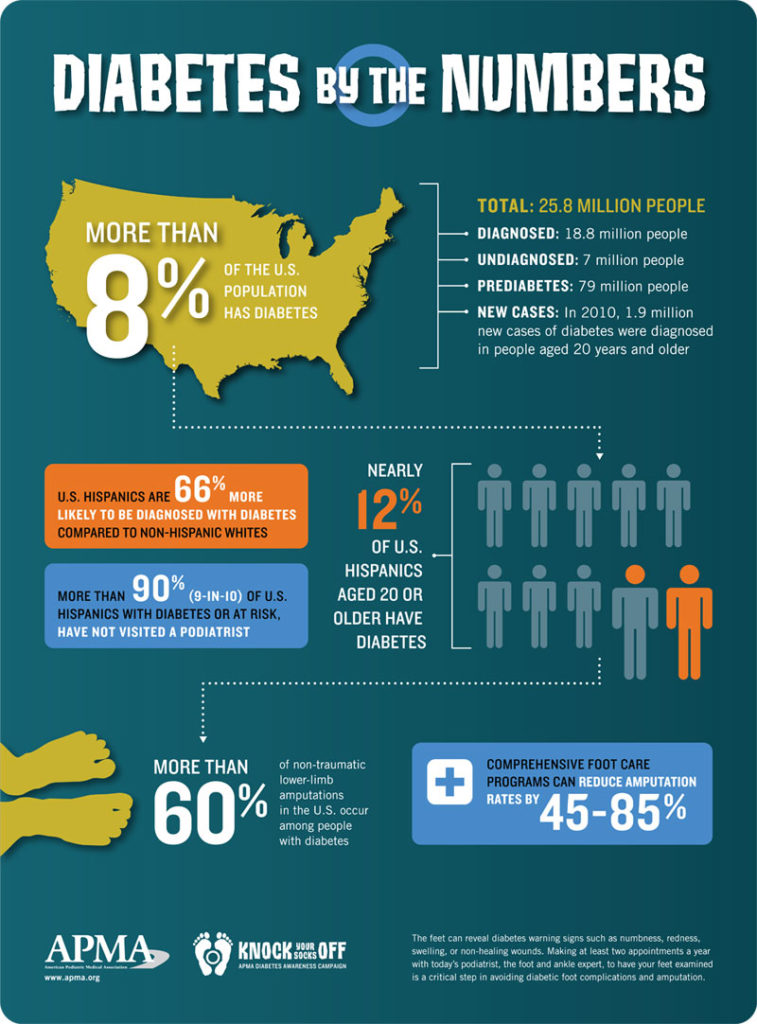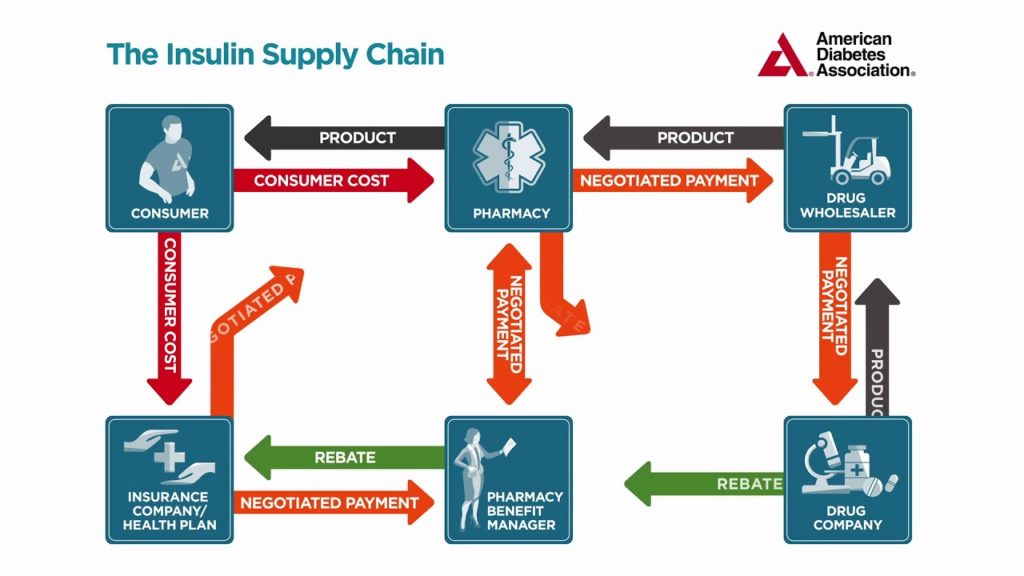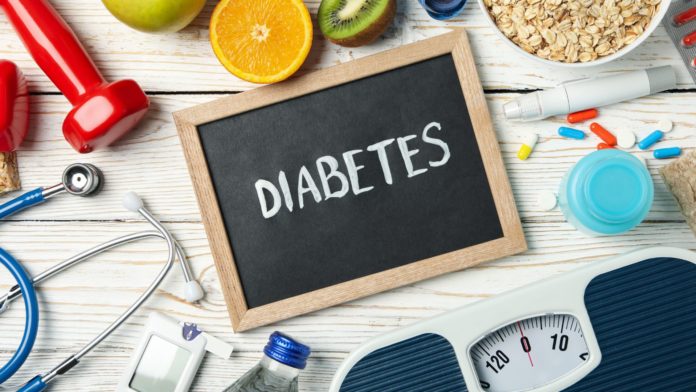Diabetes has often been called the silent killer, because a person can suffer from this disease for years with relatively mild signs or sometimes-nonexistent symptoms, and yet, the disease is slowly and silently killing them. And while the disease itself is a huge problem in the healthcare world, it’s especially problematic for Latino communities.
Latinx people are more likely to develop diabetes, but are less likely to catch their disease early and manage that illness with proper treatment and medication. In addition, Hispanics are often less likely to seek medical treatment and take insulin medication due to cost restraints and accessibility.
It’s important for everyone to be educated about diabetes, to know the risk factors, the early symptoms and the steps they can take to help prevent this illness. But it’s even more crucial that individuals in Latino communities know what they are up against, know they risk factors, and understand the impact that rising insulin prices can have on their future.
Diabetes Affects Your Blood Sugar Levels
Let’s begin with the basics. What exactly is diabetes? Diabetes is a disease that affects your blood sugar levels. It occurs when your blood glucose levels are too high. In a healthy body, the food you eat is digested and broken down, and the glucose is then turned into blood sugar, which is used for energy by the cells in your body. Insulin is a hormone produced by your pancreas, which helps transform that glucose from your food into energy that can be used by your cells. When a person has diabetes they do not produce enough, or any, insulin, so the glucose gets trapped in their blood and their blood sugar levels are above normal. When sugar builds up in the blood it can cause serious health complications over time, including, but not limited to, heart disease, vision loss, kidney disease, stroke and nerve damage.

There are several types of diabetes, some of which are diagnosed at an early age and some develop due to environmental factors later in life. Type 1 diabetes is often diagnosed in children and young adults, and it occurs when your pancreas does not produce insulin, so you need insulin therapy to survive. Gestational diabetes develops during late pregnancy and can affect both the mother and baby if left untreated. Type 2 diabetes is the most common form of diabetes, and it is more often diagnosed later in life. It occurs when your body does not use insulin properly and your body develops insulin resistance, so glucose builds up in your blood.
Diabetes Affects Millions Of Americans
Currently, more than 30 million Americans have diabetes, but one in four of those people don’t know they have it. Meaning there are millions of people in America who are suffering from diabetes, but who are absolutely clueless that they are sick, and are completely unaware about the damage that is happening inside their bodies. And while sometimes ignorance is bliss, in terms of medical care ignorance limits your ability to get treatment, and can lead to a whole host of other complications.
Of those millions of Americans with diabetes, which equates to about 9.4 percent of the U.S. population, the vast majority has Type 2 diabetes. Approximately 90-95 percent of cases in adults are type 2 diabetes, according to the National Institute of Diabetes and Digestive and Kidney Diseases.
You’ve probably heard of diabetes referred to as the “silent killer” because it has very easy-to-miss and often hard to diagnose symptoms. “Almost every day people come into my office with diabetes who don’t know it,” says Maria Collazo-Clavell, MD, an endocrinologist at the Mayo Clinic in Rochester, Minnesota. In an article for ABC News she continues to explain that one of the most common signs of diabetes is simply not feeling well, or feeling fatigued and lethargic (which, if we’re being honest, we all feel at one point of another). “When people have high blood sugar levels, depending on how long it’s been, they can get used to chronically not feeling well,” she explains. Add that to the list of reasons why diabetes can often go undetected. In fact, while over 30 million Americans have diabetes, another “84.1 million have pre-diabetes, a condition that if not treated often leads to type 2 diabetes within five years,” according to the CDC, and more often than not, those people don’t know about their condition.
And while diabetes can affect anyone of any ethnicity, Hispanics are far more likely to develop this disease, so it’s crucial that members of the Latino community know what to look for, and perhaps even more importantly, that they become familiar with their options and obstacles in terms of insulin treatment.
There Is a Higher Risk of Type 2 Diabetes Among Latinx Communities
A 2017 report from the CDC found that the likelihood of an adult developing type 2 diabetes over their lifetime is significantly higher for Hispanic men and women. 40 percent of U.S. adults are expected to develop type 2 diabetes, while that number goes up to 50 percent for Hispanic men and women. Hispanics are 50 percent more likely to die from diabetes than whites, and they are about one and a half times more likely to develop kidney failure than non-Hispanics.
A 2012 study published in Diabetes Care also found an association between ethnicity and diabetes. The study suggested that the connection has to do with where individuals store fat and how their body processes that fat. Because Hispanics often store more fat in their pancreas, they are at higher risk of developing diabetes. “In our study, we found Latinos were especially vulnerable, as they tended to store more fat in the pancreas and their compensatory insulin secretion was entirely suppressed,” explains Lidia Szczepaniak, director of magnetic resonance spectroscopy at the Cedars-Sinai Heart Institute and Biomedical Imaging Research Institute.
The study’s lead author, Richard Bergman, director of the Cedars-Sinai Diabetes and Obesity Research Institute in Los Angeles, explained that while “not all people who are overweight or obese and who have insulin resistance go on to develop diabetes, if we can determine who is most likely to develop diabetes and why, then we can make strides toward preventing it in those individuals.”
And the storage of fat isn’t the only reason why Hispanics are more likely to develop diabetes later in life. According to the American Association of Diabetes Educators, “genetics and environmental factors play a role, but health disparities in early access to screening, type 2 diabetes prevention and healthy lifestyle intervention add fuel to the fire.”
Cultural factors such as dietary habits, physical activity and genetics can contribute to the increased risk of diabetes among Hispanics. And beyond that, lack of awareness, limited access to healthcare and the increasing cost of diabetes treatments may all contribute to the higher rates of diabetes in Latino communities.
The Rising Cost of Diabetes, Especially For Latinos
It’s no secret that diabetes is an expensive disease in this country and around the world. According to the Economic Costs of Diabetes in the U.S. in 2017 report, the total costs of diagnosed diabetes have risen to $327 billion in 2017 from $245 billion in 2012. That cost breaks down to $237 billion in direct medical costs and $90 billion in reduced productivity, according to the report, with inpatient hospital care and prescription medications making up the majority of that cost. The cost of diabetes is rising, as is the prevalence of diabetes in this country, in part due to the increased risk among Hispanics. Hispanics are the largest ethnic group behind whites, and as that population grows, so does the incidence of cases of diabetes. More cases of the disease leads to increased costs, costs that many Hispanics worry they won’t be able to afford. According to a 2014 NPR report, “about a third of immigrant respondents (31 percent) said they’d had a serious problem with being able to pay for health insurance in the past 12 months. And more than 1 in 4 had a serious problem affording doctor and hospital bills and prescription medicines.” And the health issue they were most plagued by and most concerned about is diabetes.
The Rising Cost of Insulin
Part of the rising cost of diabetes among Hispanics has to do with hospital visits and preventative care such as access to nutritious foods in low-income neighborhoods. But that’s not the only source of increased expenses. The cost of insulin is rising at record speed, and it’s putting Latinos at an even higher risk.
Between 2008 and 2013 the cost of insulin medications jumped significantly, nearly tripling in just 5 years. “The mean price of insulin increased from $4.34 per milliliter in 2002 to $12.92 in 2013” according to a 2016 report published by The Journal of the American Medical Association. And in 2017 alone, insulin drugmakers Eli Lilly (LLY) and Novo Nordisk increased their insulin list prices by almost 8 percent each, according to CBS News.

This increase in price is putting diabetics, especially diabetics in low-income households, in a precarious situation. They are forced with the choice between certain essential everyday expenses such as food or rent, and paying for insulin medications. The price hike is making insulin treatment unaffordable for some patients, and they are choosing to cut back on insulin because of this cost — a decision that could be deadly, as regulating insulin is a crucial step in managing diabetes and preventing permanent, perhaps fatal, damage to the body.
Rising insulin prices can be attributed to several factors, but lack of competition from generic brands is certainly at the top of the list. Currently there are three drugmakers producing insulin treatments: Eli Lilly, Sanofi and Novo Nordisk. They make up 99 percent of the insulin drug market, and there are no generic medications available. In addition, there is a very vague and often tangled relationship between insurance companies, pharmacies and drugmakers. According to William Cefalu, chief scientific, medical and mission officer at the American Diabetes Association, in an interview, “there is a lack of transparency throughout the insulin supply chain. It is unclear precisely how the dollars flow and how much each intermediary profits.” And while that supply chain is complicated and unclear, one thing that is very clear is that diabetes patients, especially Hispanic diabetes patients, are suffering the consequences.
Americans Are Crossing The Border To Access Insulin Treatments
The rising cost of insulin treatments in the US is forcing some diabetics to make deadly choices of whether or not to buy and take their medications. Others are looking for other solutions that take them across the border to Mexico and Canada.
According to T1International, a non-profit advocating for people with Type 1 diabetes, people with diabetes are seeking alternate sources of insulin treatments by visiting pharmacies in places like Tijuana. There they hope to stock up on their life-saving medications that they can no longer afford in the US. A year’s supply of drug treatments that could cost upwards for $3,000 in America cost only $182 in Mexico.
This is clearly not an ideal solution, and especially for Latinos who may have come to America in hopes of a better life and better access to healthcare, the thought of crossing the border just to be able to afford insulin medication seems absurd and completely unfeasible. And yet, here we are.
The good news is that patients are fighting back, and lawmakers are also fighting the fight to protect diabetes patients and help keep drugmakers in check to make insulin treatments affordable for everyone. In 2017, the U.S. District Court of Massachusetts filed a class-action lawsuit against the three insulin drugmakers stating that by raising insulin prices they were violating the Racketeer Influenced and Corrupt Organizations Act, and were a part of an “organized scheme to drive up prices at the expense of patients who need insulin drugs to live.” In response to the suit, the drugmakers responded by offering discounts for people with high-deductible insurance plans, and by committing to limit all future drug list price increases from the company to single digit percentages.
So what does this all mean for people suffering from diabetes, particularly those in the Latino community?
First and foremost, we need public policy and private sector solutions in this country to help people dealing with diabetes. There needs to be more transparency in terms of drug pricing policies and how those costs affect all parties involved, from the drugmakers to the pharmacies and insurance companies, to the patients. But those shifts in the healthcare world could take a long time, and many diabetes patients, especially Latino patients, don’t have a long time. Education is key, awareness is essential, and it’s more important than ever that Latino communities focus on early diagnosis and management of diabetes. Healthy lifestyle changes, healthier habits and a focus on preventative medication are important, particularly for members of these higher-risk communities. Diabetes affects tens of millions of people in this country, and it’s imperative that those at risk, especially Hispanics, become a part of the conversation and make their health a priority.
For Image credit or remove please email for immediate removal - info@belatina.com


































